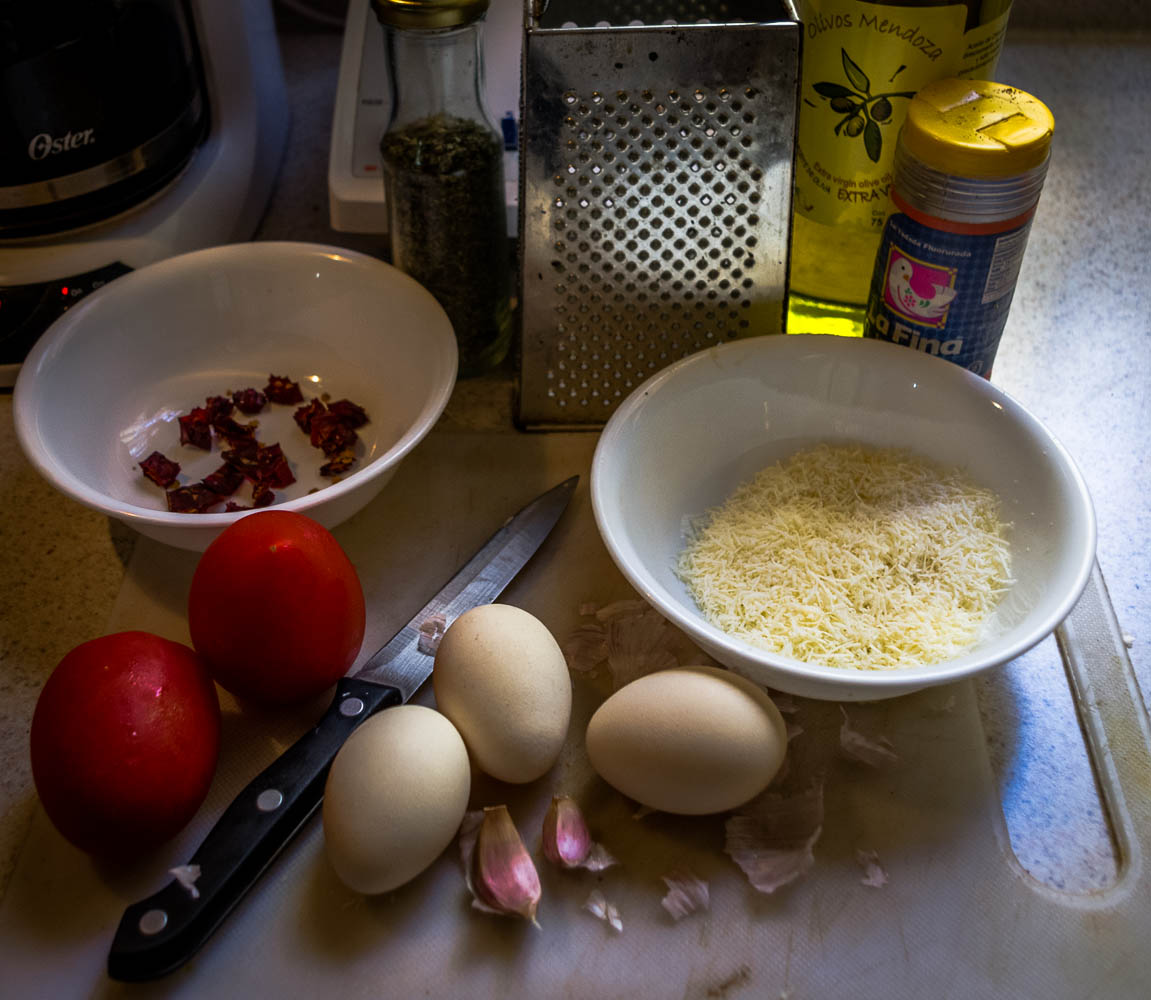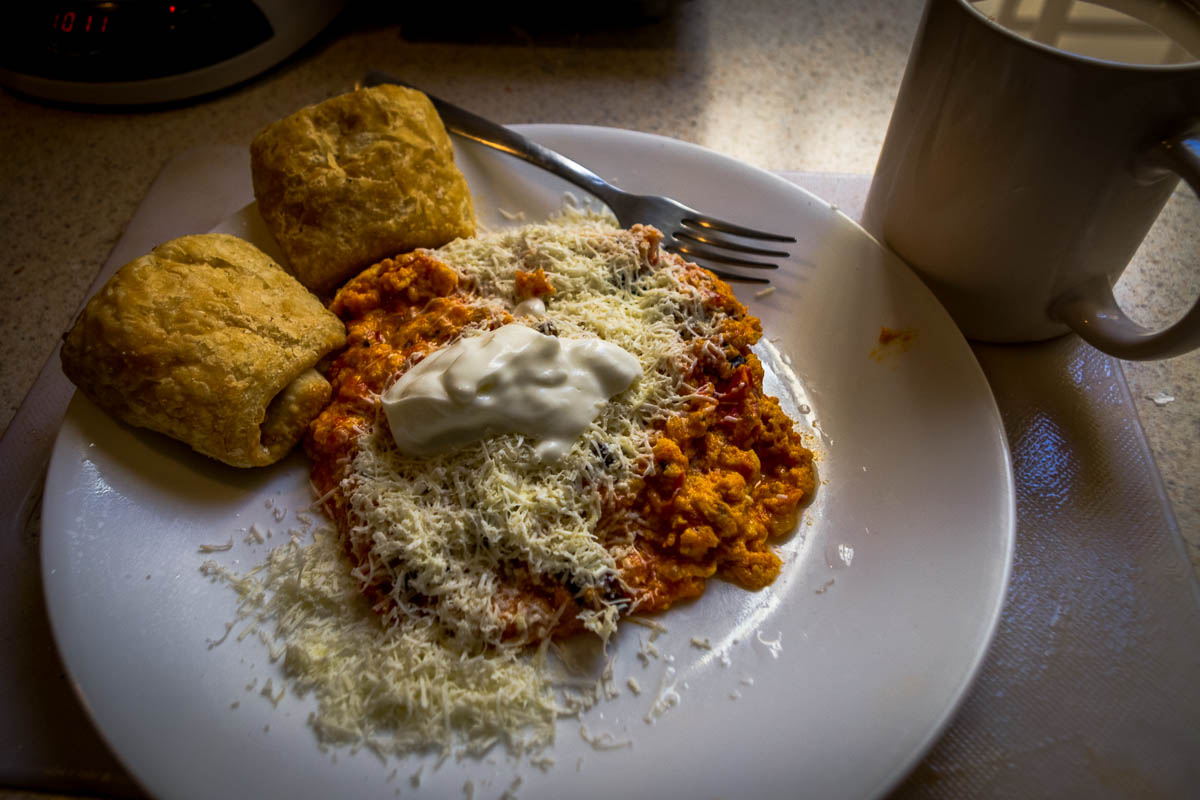One A Day – 479 – A Recipe

Ingredients for a Simple Breakfast in My Kitchen
The Finished Breakfast
- My kitchen
- Morelia, Michoacán, México
- June 21, 2014
- Copyright, all rights reserved
I’ve been a bit lax with my daily posts lately. I’ve been very busy with work and frankly, I arrive home at night and sink into the couch to rest. By the time I have myself back to where I might be interested in something more than being vegetative – it is time for bed. But this is a weekend so I will try to put a few posts out today and hey – a recipe!
A Mexican Twist on Stapatsada
Strapatsada is a traditional Greek recipe that produces a very nice plate of custardy scrambled eggs with a very simple method. Making it is a bit more of a mess than I sometimes want on a Saturday morning, but still, it is a great recipe to serve.
Living in Mexico, I like to make a little variations on the traditional recipe using local ingredients. There are lots of things you can try, but keep it simple until you get the method. Honestly, this is so much like making a Mexican salsa, the only thing that will surprise Mexicans is, “we didn’t think of this first?”
One serving . Maybe two if you add freshly toasted bread or great tortillas, fresh fruits and juice. Coffee? Of course!
Ingredients
1-2 dried morita chile cut into 1/4 inch rings
1 clove garlic (2 if you are brave)
2 roma tomatoes
2-3 tablespoons extra virgin olive oil
1/4 teaspoon oregano (pinch)
3 eggs, whipped with a fork to a smooth yellow
Salt to taste
1/2 cup shredded cotija cheese
Optional garnishes
– Chopped parsley or cilantro, cubes of avocado, a spoonful of strained yogurt
Preparation
- Slice the morita chile into rings and knock the seeds out. Don’t be too picky, a few remaining seeds won’t hurt you. I just like to avoid the bitterness you will get from frying the seeds. If you can’t find moritas (smoked, red ripe jalapenos), chipotle will work, but they are larger and add a more raw heat. You could also use puya chiles but they are not smoked. One puya is plenty and if you are using the dry, dusty-colored chipolte – you may want to just use half.
- Sliver the garlic. You could chop them to dust I suppose, but you want to be able to control frying to the point where the garlic will just start to color, nothing more. The smaller the pieces, the less controllable the frying.
- Grate the cheese. If you can’t find cotija, you could also use queso fresco (a soft Mexican cheese that crumbles like feta), feta, or Italian parmesan
- Grate the tomatoes. Now this is the step that is critical. Knowing that almost everyone has a blender or food processor sitting in their kitchen – I know there will be a great temptation to simply puree the tomatoes. Don’t. The consistency of the tomatoes is important in this dish because it is so simple. There will also be a tendency to want to use canned tomatoes or tomato sauce. Please don’t go there. You won’t be impressed. Don’t worry about the skins of the romas, The trick is to cut off the stem end and simply start grating with a box grater over a plate. Any skins left at the end, can be dumped (it will be in your hand, the grater is very efficient for removing a good amount of the skin) or sliced thinly and added back to the grated tomatoes for a more rustic look and feel. If you must use “bolas” (round tomatoes) be aware that they have a much higher ratio of water to flesh and it may take a little practice to get the right number of tomatoes and get them to the right consistency when you reduce them.
- Prepare your garnish. Once you plate the eggs, you aren’t going to want to wait.
Frying
- Heat a small saute pan. It doesn’t need to get too hot – moderate to low heat is fine to start. The size of the saute pan matters in this case. If the pan is too large, the egg and tomato mixture will spread out too much at the start and not achieve the custard-like consistency. Use the same size pan you would for a couple of fried eggs or a single portion omelet.
- Add olive oil, let it heat a little. Add the morita rings and fry until they change color just a bit. This happens very fast, so I always have a fork or slotted spoon handy so I can pull the pan off the fire and take the rings out as soon as they are toasted. Don’t let them get too brown. They will lose favor and be bitter. Set them aside. In the same oil, fry your garlic until it just starts to turn golden.
- Add the oregano and stir it just a second to toast it. Then, immediately add the grated tomatoes. This is going to spatter bit at first, especially if your pan is a bit hot. As it calms down, raise the heat to a nice steady boil. You want to reduce the tomatoes to a chunky tomato sauce consistency, removing a lot of the water. Add salt to taste. As it nears of the right point, the smell of a garlic tomato sauce will become quite apparent. People will begin to hover.
- When the tomato sauce is at the right consistency, lower the heat a bit, then add the fried chile rings and the whipped eggs. Use a wooden spoon or bamboo spatula (if you have one) to stir and fold the tomato and egg mixture. At first, you are going to see some solid bits of scrambled eggs where they come into contact with the pan. Don’t fret, just keep stirring and folding. In a few moments, the mixture will start to thicken and begin to meld into a custard-like consistency. This is the point where you have some choices. I prefer my scrambled eggs soft and creamy. Some people just have to have them hard scrambled. You will find as you continue to slowly stir and fold they will become more firm. Stop just below the point you think you would like. Don’t be afraid to try them looser than you might ordinarily. They will continue to stiffen for a few minutes after you remove them from the pan.
- When they are at the point you think you want (or just before), spoon them out on to a plate and garnish. Serve with a smile. You just learned the secret to custard style scrambled eggs. The low temperature does the trick. In this case, the tomato sauce keeps the egg from getting hotter than boiling and gives you more control over the finished product.
Provecho!

